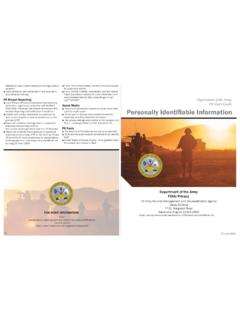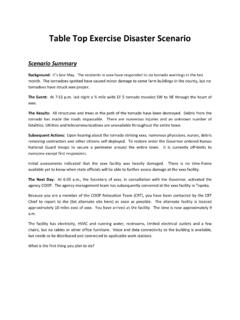Transcription of Tips for Understanding and Working with Others
1 tips for Understanding and Working with Others When Working on communicating, we need to find ways to "connect" with Others . Apart from a common language, we need to share interests and terminology to understand what the other is saying. In the same way, we must work to bridge our differences in personality. The following rule generally holds true: The further away you are from someone on the personality grid the more difficult it is to relate to them. For example, a highly analytical person will likely find it difficult to work with someone who is very expressive. The same conflict could occur between a driver and an amiable. This is because their ways of thinking and Working are quite different. Most of the time we will not have the luxury of choosing who we will work with. Because of this, we must work with all personality types. To do this effectively, you will need to: Observe. Listen and watch for personality cues; be open to someone else's style, values and perspective.
2 Adapt. Find common ground with someone who is different; this could be your speed of speaking or the terms you use ( , talking about facts vs. feelings). Connect. Watch for body language and get feedback from Others to see if you are being understood;. check your own thoughts/feelings. Do you feel harmony or discord? The objective is to understand and relate to all other personality types. That is when communication clicks and Working together works best. In order to better understand personality types, it is best if we understand our own personality type. The Value of Personality Analysis Here are some ways the personality analysis can help you become a leader: Increased self-acceptance. You will begin to accept more of your strengths and your weaknesses. Improved awareness. You will recognize where your strengths can become weaknesses. More perspective. You will be able to see (and have more Understanding of) different sides of yourself and Others .
3 Greater choice. Knowing different personality qualities, you will be able to develop the ones you want. More Understanding and ability to work with Others . You will see the strengths and needs of people around you. Enhanced personal growth. You will feel more balanced, more integrated, and whole. Continue to the assessment: SELF-ASSESSMENT OF SOCIAL styles . Use the questionnaire and chart on the next page to assess your social style. Total your score on assertiveness and divide by 15. Then total your score on responsiveness and divide by 15. Plot the two average scores on the chart (back page). Assertiveness Ratings Responsiveness Ratings I perceive myself as: I perceive myself as: Talkative 1 2 3 4 4 3 2 1. Slow to Decide .. Fast to Decide Deliberate 1 2 3 4 4 3 2 1. Going Taking charge Using opinions ..Using facts 1 2 3 4 4 3 2 1. Challenging Informal .. Formal 1 2 3 4 4 3 2 1. Unemotional 1 2 3 4 4 3 2 1. Fast to Decide Easy to to know 1 2 3 4 4 3 2 1.
4 Asking questions ..Making statements 1 2 3 4 4 3 2 1. Cooperative .. Competitive Calm 1 2 3 4 4 3 2 1. Avoiding Taking risks Poker-faced 1 2 3 4 4 3 2 1. Slow, studied .. Fast-paced People-oriented ..Task-oriented 1 2 3 4 4 3 2 1. Carefree Spontaneous .. Cautious 1 2 3 4 4 3 2 1. Firm Responsive .. Nonresponsive 1 2 3 4 4 3 2 1. Humorous .. Serious 1 2 3 4 4 3 2 1. Matter-of-fact 1 2 3 4 4 3 2 1. Reserved ..Outgoing Intense 1 2 3 4 4 3 2 1. Total Score = _____ / 15 = _____ Total Score = _____ / 15 = _____. SELF-ASSESSMENT OF SOCIAL styles . Dominance Scale Low Responsive Controlled . 1. ANALYTICAL DRIVER. (Thinking) (Sensor). Sociability Scale Sociability Scale Low Assertive High Assertive 1 4. Asking Telling . AMIABLE EXPRESSIVE. (Feeling) (Intuitive). 4. High Responsive Emotional . Dominance Scale Assertiveness Dominance The degree to which a person attempts to control situations or the thoughts and actions of Others .
5 Responsiveness Sociability The readiness with which a person outwardly displays emotions or feelings and develops relationships. Driver Sensor Quick reactions to here and now sensory input Expressive Intuitive Imagination and thought Amiable Feeling Emotional and personal reactions to experiences Analytical Thinking Logically organizing and analyzing data 2. Four Social styles ANALYTICAL: Low Responsiveness, Low Assertiveness Analytical people can appear unsociable, especially to Amiables and Expressives. They may seem serious and indecisive. This is because they need to look at every conceivable angle before they feel satisfied. A consequence of this is that they are persistent in their questioning and focus on detail and facts. However, once they have made a decision, they stick with it as they invariably feel that it is infallible. In conflict, they can "whine", become sarcastic and are often negative. Summary: Characteristics: Serious, mull matters over, Indecisive, persistent, ask lots of questions, attention to detail.
6 In conflict: whining, sarcastic, negative Solution: Keep to the facts, Don't agree with them, listen attentively Basic Need: To be correct DRIVER: Low responsiveness, high assertiveness Drivers are task orientated and expect efficiency from everyone they come into contact with. Little emphasis is placed on building relationships with other people. They can be perceived as aggressive and uncaring, especially by amiables, though are often needed to take risks and push things through. In conflict, they will try to " steam roller " over anyone who comes in their way. Summary: Characteristics: Task orientated, clearly defined goals, committed, determined, risk takers, efficient. In conflict: Aggressive, rude, abrupt, Solutions: Be assertive and firm, have a solution to the problem, listen. Basic Need: To be in control Four Social styles AMIABLE: ( High Responsiveness, Low Assertiveness ). The amiable person likes other people's company, though is more of a listener than a talker.
7 Expressive people find them useful, because they are prepared to listen to what they are saying. They are loyal, personable and show patience when dealing with other people. They may however not be perceived as people " who get things done " because they spend more time developing relationships with Others . They are also unlikely to take risks as they need to have the feeling of security. In difficult situations, they are likely to avoid the situation and lack conviction of their feelings and if pushed likely to make promises that they cannot keep. Drivers often find them frustrating because they want a straight answer and the amiable can find this difficult to deliver. Summary: Characteristics: Loyal, personable, patient, Uncomfortable with risk, Non-Confrontational, Dislike pressure, Enjoy the company of Others . In conflict: Likely to be " passive", lack conviction, avoidance, Solution: Reassure, Support, Confirm commitment Basic Need: Security EXPRESSIVE: ( High Responsiveness, High Assertiveness ).
8 The expressive likes the company of other people, though unlike, the amiable this is because they need to " express " themselves. Amiables complement them very well, unless the expressive becomes too aggressive and puts them off. They can be good people to have at a party, because they're enthusiastic, dramatic and "interesting" people to have around. However, if they don't receive the attention they crave, they can get upset and even "difficult" to deal with. In conflict, they become emotional, prone to exaggeration and unpredictable. The best way to deal with this is to let them calm down. Try not to fuel the fire by saying anything controversial. Summary: Characteristics: People orientated, centre of attention, positive, emotional, talkative, enthusiastic, dramatic. In conflict: Unpredictable, emotional. Solutions: Allow them time to gain composure, Ask questions, problem solve. Basic Need: Recognition o Low assertiveness o High assertiveness Analytical o Low responsiveness.
9 Drivers o Low responsiveness. o Technical specialists. o Control specialists. o Likes organization and structure o Decisive in action and decision making o Dislikes involvement o Likes control; dislikes inaction o Asks specific questions o Prefers maximum freedom to manage self and Others o Prefers objective, task-oriented, intellectual work o Cool, independent, and competitive with Others o Wants to be right, so collects much data o Low tolerance for feelings, attitudes, and advice of o Works slowly, precisely, and alone Others o Seeks security and self-actualization o Works quickly and impressively alone o Has good problem-solving skills o Seeks esteem and self-actualization o Has good administrative skills o Low assertiveness o High assertiveness Amiables o High responsiveness. Expressives o High responsiveness. o Support specialists. o Social specialists. o Slow in making decisions or taking actions o Spontaneous actions and decisions o Likes close.
10 Personal relationships o Likes involvement o Dislikes interpersonal conflict o Exaggerates and generalizes o Supports and actively listens to Others o Tends to dream and get Others caught up in those dreams o Weak in goal setting and self-direction o Jumps from one activity to another o Seeks security and identification with a group o Works quickly and excitedly with Others o Has good counseling and listening skills o Seeks esteem and group identification o Has good persuasive skills The Interaction of styles Style flexing is the ability to adjust your style to meet that of your prospect Source styles Shared Dimension of Conflict Area of Agreement Analytical v Amiable Low Assertiveness Priorities Pace Driver v Expressive High Assertiveness Priorities Pace Analytical v Driver Low Responsiveness Pace Priorities Amiable v Expressive High Responsiveness Pace Priorities Analytical v Expressive Both Amiable v Driver Both Style Summary Driver Expressive Amiable Analytical Backup Style Autocratic Attacker Acquieser Avoider Accuracy "Being Measures Personal Values By: Results Applause Security Right: For Growth Needs to Listen Check Initiate Decide Allows to build own Needs climate that Inspires to reach goals Provides Details Suggests structure Takes time to be Efficient Stimulating Agreeable Accurate Conclusions and Relationships and Support their Dreams and Intuition Principles and thinking actions feelings Present benefits that tell What Who Why How Options and Testimonials and Guarantees and For decisions give them Evidence and service probabilities incentives assurances Their specialty is Controlling Socializing Supporting Technical tips for Your Type For the Amiable: Speed up with "fast" people Talk more, listen less Take control occasionally.












